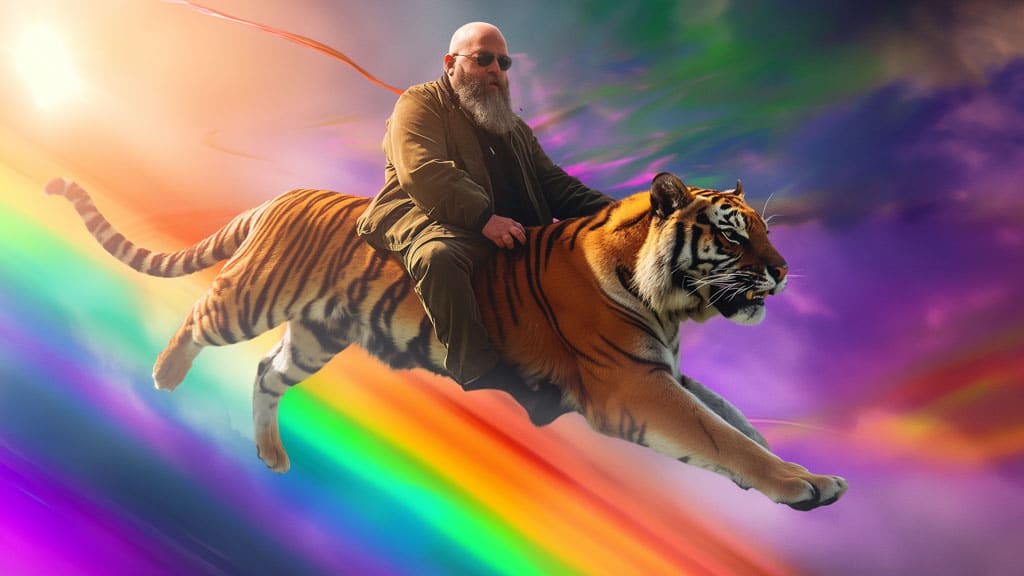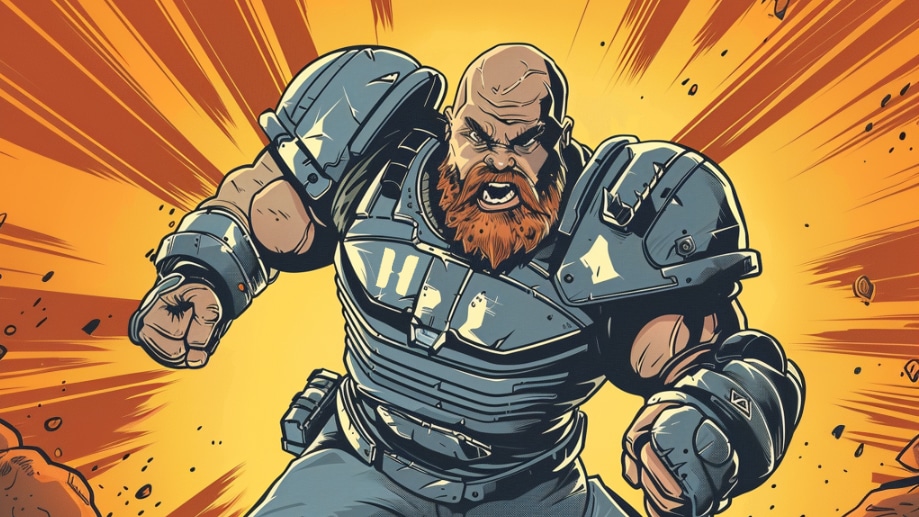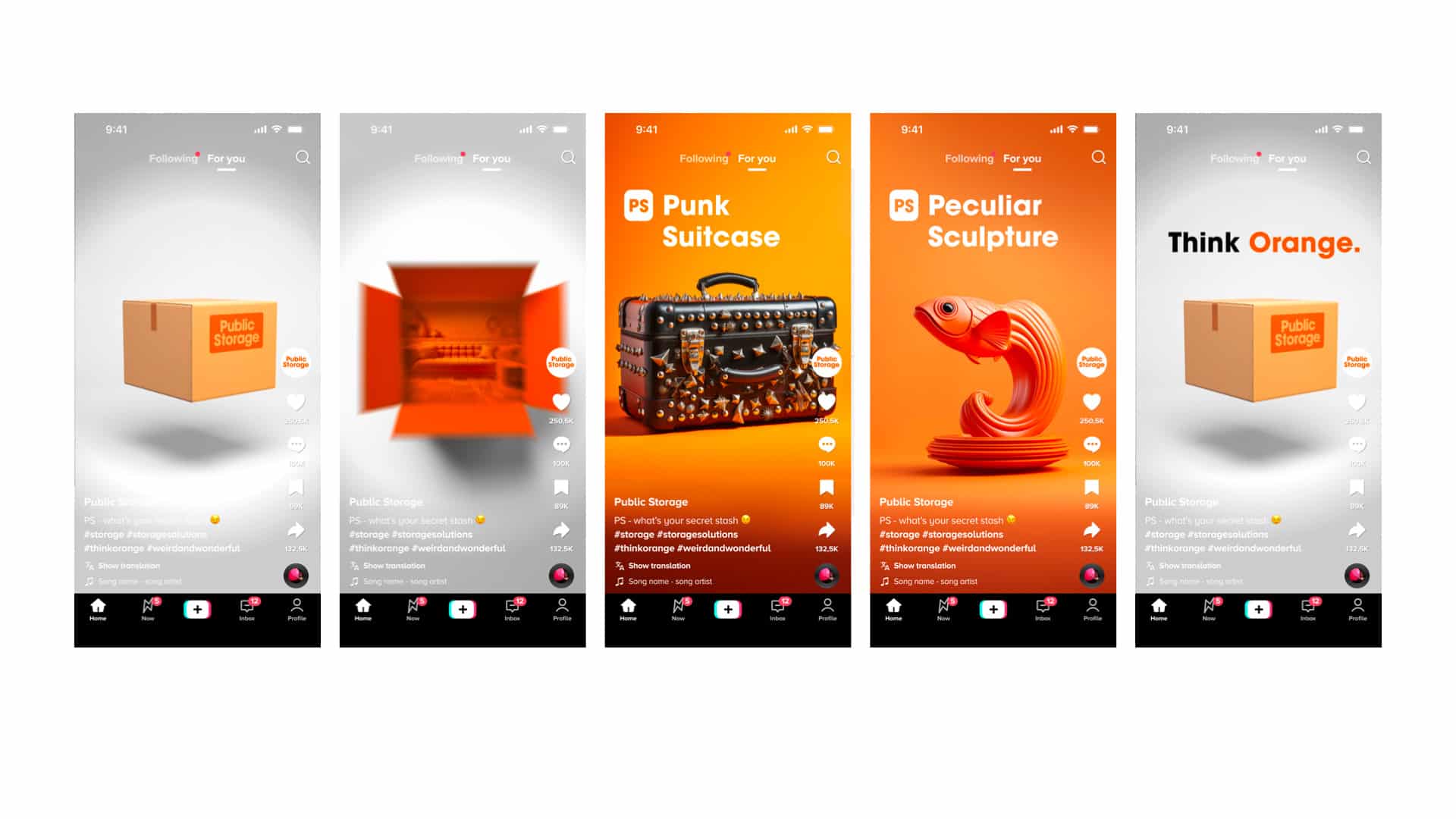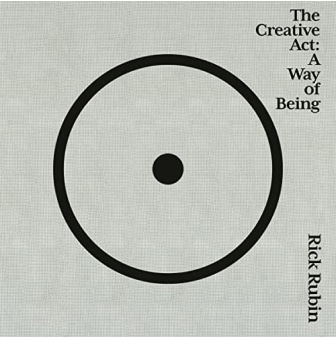AI:
Not the thing,
but a great thing
An overview of the AI impact within the Hero Digital creative team.
There’s a new “blockbuster” movie that just came out that features Jennifer Lopez fighting an “evil AI” in the future. Yes, an evil AI.
Spoiler Alert (but honestly if you watch that movie you deserve it) We quickly learn that J-Lo helped build the AI-being to help us, but it became self-aware, and logically concluded that humanity is the threat to everything, and decides to get rid of us all. Lots of lasers and close-calls ensue.
(Sigh.)
In reality, AI is not evil (…yet?)
And it’s (probably) not going to take all of our jobs. I mean, we survived Pagemaker, QuarkXpress, and the entire “publishing revolution.” Pretty sure creative teams will survive this, too.
But one thing is for sure—AI is more than a fad. As Hero’s (self-appointed) Director of Shaking a Fist at Kids on Our Lawn, I can say this with confidence, as many of us (cough cough) “seasoned professionals” have seen actual fads come and go.
Rotating logos on the homepage. Flash. The deli meat client who needed an RSS Feed. When every single brand wanted a blog, then totally ignored it. When every site suddenly looked like a Flickr wall (which was still better than Flash). Parallax. The list goes on and on…
Our EVP of AI, Arun Kumar, a mega-smart and very handsome man, recently released a great white-paper about AI. Arun does a great job of explaining the relationship between data and AI and our vision for AI at Hero. And, while it will always be fun to query AI to “show me what I would look like riding a flying tiger,” there is definitely a bigger opportunity here.


And the creative team? We’re being asked about AI on a daily basis. We’ve even formed our own AI Ambassador team (like, literally the other day) to respond and to stay at the forefront. Hopefully you are also curious about how we’re using AI, because that’s what the rest of this article is about.
According to every poll ever made on the topic, 300% of creative professionals are using AI in their work.
Yeah, there’s a lot of noise out there on this topic. The goal of this article is to not do that. But the truth doesn’t make for a compelling headline, like that one above.
Here’s the truth: AI is a thing, and it’s a pretty great thing, but it’s not the thing. Or, at least, not the only thing.
Every single one of us is actively using some kind of Large Multimodal Model (LMM), and most of us are going beyond “show me as a robot-Viking,” which, honestly, will never get old, but doesn’t help (most of) our clients.


Sure, we have some skeptics—ironically some of the younger members of the team. There’s lots of talk about the environmental impact and energy consumption of the server fields. Not to mention the way that these tools have been trained—chock full of harmful, antiquated biases. But for the most part, we’ve all found AI helpful, fun, and even exciting at times.
We get to wear new hats!
The whole creative team was asked to contribute to this article. And the first thing that stood out was people venturing out of their lanes with the help of AI.
“Grammar check—I’ll write out what I want to say, then ask ChatGPT to reformat. Me no good with words” said one of the younger designers. This sentiment was consistent across the board. Instead of Lorem ipsum, many designers and art directors were filling in text, instead of waiting for a writer to jump in.
Anthony, our ACD/Art Director, is a regular user. “I use ChatGPT to research industry trends in tone, messaging and indicators that can inform creative campaigns. And it’s much easier to review write-ups for pitch decks, and reduce copy when needed.”
The writers are happy, too
There’s an old philosophy in creative departments around the world—don’t give the writers design applications. While they might roll their eyes when others contribute copy to projects, it’s nothing like the “design work” copywriters bring to the ideation sessions.
That has changed.
“I have a basic grasp of Photoshop, so, yeah, I’ll try to bring my ideas to life to sell them to the team. Now I can tell Midjourney,” said one of our writers from behind a screen with an altered voice. “Public Storage for example. The idea was to bring the P and S to life with interesting visuals, like a ‘punk suitcase,’ which took me 10 minutes to make, and looked awesome.”
And now, other ways we’re using AI without quotes from people:
- Adding “more image to an image” — we use it to extend backgrounds and change a photo’s aspect ratio for stronger art direction and cropping.
- Evolving an image from 2D into a 2.5D space — we used it to create a 2.5D view out of a 2D render of a house to show how it might rotate when a user hovers over it.
- Directing photoshoots —we’re able to go far beyond a description now without spending hours in Photoshop; generating concept images gives our photographers a well-defined goal.
- Firefly — we can quickly “add an onion” to a layout (for our french-fry client) without all the work of finding/editing the image.
- ElevenLabs.io — we’ve created voiceover tracks for quick-turn videos. Yes, you can tell if you listen closely, but it’s been great for those needs.
- Categorizing and structuring content — AI can convert unstructured data into tables, csv files, and other structured formats. For instance, we can give it a long list of uncategorized product features/benefits and ask it to put them into logical groups and display them in a table format.
- Summarizing user insights from testing results — UserTesting’s Instant Insights tool detects sentiment, keywords, and other indicators, reducing the time spent manually analyzing the data.
For all of us, AI isn’t the end, but rather a new beginning
Remember Arun, the smart guy mentioned above? He said it well: “For creative, the biggest short-term win I see is the ability to concept without fear. You can let your imagination run wild knowing that AI will help you deliver it.”
This comes toward the end of this article, because it’s really the big point…
We can rely on AI to hit the ground running
“Blank page anxiety” is the feeling we have at the start of a project. Until recently, we’d open a new page or board, and wonder where to even begin. Everyone can relate to this feeling, and it’s especially true for creative professionals.
“I’ll just prompt ChatGPT to give me headlines about whatever it is I’m working on,” said the anonymous writer quoted earlier. “Now, I’ve never actually used anything it’s given me, but I find starter ideas within the results…it’s better than staring at the brief.”
Bottom line: AI enables us to create beyond the limitations of our existing software—optimizing our creativity, allowing us to do more, and to do it faster and, often, and better.
No, it’s not evil. Nor is it the next big thing. But it’s a great thing. A useful, neat, and exciting thing that we’re learning more and more about. And, likely, it’s learning more and more about us…fingers crossed it doesn’t decide that it doesn’t need us any time soon.
More articles coming…stay tuned
We’ll keep you updated on our progress, probably with lots more details (and fewer jokes inside of parentheses), especially now that we have a fancy AI Team. I’m pretty sure my colleague, the Director of Skeptical Side-eyes, will likely provide a counter argument in our next edition.


Cool. Now what? How “The Big Idea” shows up in 2024.
Recently, Hero Digital won the pitch for the nation’s largest self-storage company, Public Storage. The invitation was clear: show us the “big idea.”
But what does that even mean today?
We didn’t win the business because we had a Big Idea
It was because we knew what to do with one. Yes, the idea helped, but knowing what to do with it is what mattered. Anyone can get attention. It’s harder to keep it.
The term “big idea” can be traced back to David Ogilvy in 1948—“It takes a big idea to attract the attention of consumers and get them to buy your product. Unless your advertising contains a big idea, it will pass like a ship in the night.”
And a few things have changed since 1948. Like the internet and stuff. But what hasn’t changed:
- Ideas come from people
- Ideas are then judged by other people
- They’re shaped by a lot of factors as they move through the process
- They are not the solution; they are a part of the solution
Sometimes an idea is a part of a solution. For Public Storage, we knew that our Big Idea would be a minor component of the solution—like the paint job on a new car. Because, while it will attract attention, what really matters is what’s under the hood.
Lead with it—score some smiles. Yes, we used AI. No, that’s not a real “Punk Suitcase” or “Peculiar Statue.” Well, not yet, anyways. Score some laughs. Win the room.
But then get into the major components: the strategy behind the success.


The Big Idea has a long history in the creative professionals’ world.
And it became the major component for decades, with a smart media buy as the strategy. Books were written, TED Talks were given, and the next generation was taught its importance.
Then, overnight, the world went digital—and analytics became king.
Suddenly we could tell exactly how many people interacted with a message. A carry-over from direct marketing, we quickly embraced the new world because it’s what our clients demanded. And Big Ideas, head held high, took a backseat, if even having a seat at all.
As always, we adapted to the world around us. And the new generation, born into the world of digital, came to work with a better understanding of what was going on—but without the “classical training” of the more-senior staff.


Ideas aren’t back, because they never left.
Hero Digital didn’t win the Public Storage business because we had a Big Idea—it was because we knew what to do with one. That’s the difference in 2024.
The Big Idea is how we bring the strategy to life when engaging with customers—and we have what it takes to focus on those specific, important moments. We design end-to-end customer journeys based on data, and the insights found within.
Insights are the path to relevance.
And relevance is mandatory for an idea to be a Big Idea. Any idea can get attention. But a Big Idea reflects the human need, while connecting it to the business need.
Because we are a digitally native agency, we can understand the micro-attributes and behaviors of an audience, not just the macro view. From the brand story to the campaign, from sales enablement to earned loyalty, our strategy is always grounded by an in-depth understanding of your customers
Our technology platforms have brought a new world to life, in real time. And everything has changed. Except one really important thing.
People still want a connection with the goods & services they spend money on.
We can find the strategy in the data, but transforming strategy into an idea is an art. And not a lost one.


The Creative Act: A Way of Being, by Rick Rubin
A Book Review by David M.
Is it possible to write a how-to book on being creative? Turns out, it is.
In the most surprising ways, Rick Rubin goes through a series of (we’ll call them) exercises to unlock one of the most fundamental superpowers we have as human beings — creativity. His insights are a collection of his experiences and observations working with wildly creative people, and helping them unlock the next level in their creative journey. It’s a surprising, insightful, and inspiring read that will make you want to bust out your crayons and simply start working on something, anything — just to feel that rush that comes from discovering something new.
Highly, highly recommended.


The Tortured Poets meet our tortured writer
A Review by Bryan M.
First, a little context:
I am an old metalhead who likes death metal, melodic death metal, progressive death metal, doom metal, death-doom metal, sludge metal and death-doom-sludge metal. All of those are real things.
Ok, album loaded up.
Wait…this is…this is over 2 hours long?
And all the songs are like 3 minutes? So there’s…THIRTY ONE OF THEM??? That’s weird to me. Metal songs are 10-15 minutes. 6-8 per album. OK, doesn’t matter. I’m committed to this. Let’s go.
Fortnight
I see this song has that guy who made face tattoos cool. Man, I miss when tattoos were only for really bad dudes and ladies at the circus. She just sang really loud, and that was good, but…let’s move this along, Taylor.
The Tortured Poets Depart…
“You look like Clara Bow in this light…” I’m surprised she knows who that is. Kids today don’t believe anything prior to 1995 existed. This song is ok. I don’t hate it…no one should “hate” this. It’s fine. But moving on.
My Boy Only Breaks His Fav…
Sounds like the last one. I believe she plays guitar? I remember liking that about her. Wait – I just realized it was playing on shuffle, so those reviews don’t actually match the song title, but really, does it matter?
Down Bad
Started a little differently, then not.
So Long, London
Did you know TS was never on American Idol? I thought that’s where she started. I’ve never been to London. I figure if I’m going to travel that far, it should be to a very different country, but that’s just me.
The next 5 or 8 songs
I need to get back to billable work. But I said I was committed to this BUT that was before learning there were 31 songs. Then I thought I saw “Iommi,” like Tony Iommi from Black Sabbath but no, it’s not about Tony. Least metal song so far.
Next batch
Look, I know MY music all sounds the same, but c’mon TS, can’t we get a rap or something? Maybe it’s in there and I just missed it but c’mon.
Clara Bow
Now WAIT ONE SECOND YOUNG LADY…TS mentioned Clara at the top of the album, and here we are. Clara Bow was the original it-girl but then married a dude and dropped off the planet to live on a ranch somewhere.
And didn’t TS just meet a football player (something else I know nothing about)?
Pretty sure she’s out. Sorry to bring the bad news. Don’t shoot the messenger. I have family.
Rest of album
It’s fine.
Conclusion
Taylor, I hope you read this and take my advice to heart. You need to get out of your comfort zone. Let’s take a look at a real superstar—Beyoncé. What can we learn from her?
Let’s start with this: Beyoncé made a country album. As the Washington Post said, “Cowboy Carter has reignited conversations about what country music is…who gets to define the country genre…”
I can help you there with two words:
Go metal 🤘
The heavy metal community is exceptionally open and friendly. We would welcome you with all of our blackened hearts. Take all that drama and pain, and don’t sing it—scream it. See this playlist for some inspiration.
Tortured Poets Department? Try Torture the Poets. See? Simple. We can work with what you already have.
Or, you can go the way of Clara Bow, and disappear with your boyfriend to some remote farm and keep singing your little songs, all alone.
Your call. Hit me up.